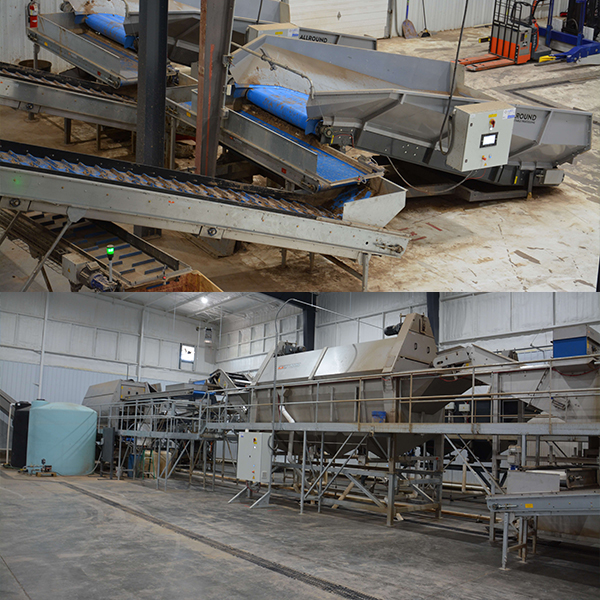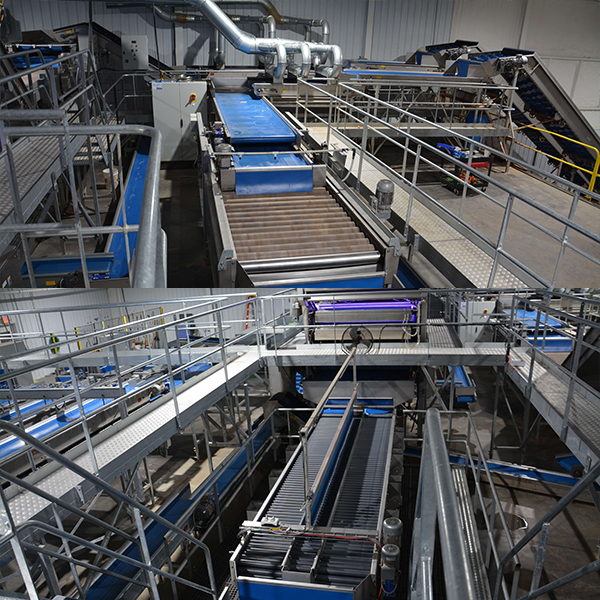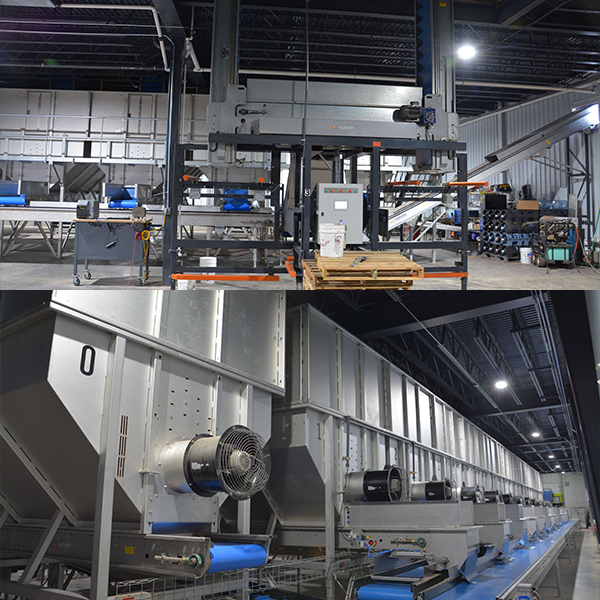Table Potato & Minis 60 t/h
we have realized a complete distribution center for a company that grows, packages and distributes potatoes all over the country. The clients of this distribution center are retail as well as wholesale. However, their main market is the whole sale market. In four months’ time a huge number of acres of potatoes has to be pushed through the installation. A 60 tons per hour washing and grading installation for potatoes. The entire installation is situated in one building. The building is designed around the installation. The storage section consists of 13 tanks placed under the mezzanine. Working with a mezzanine with under storage hoppers / tanks has several advantages. You save space. The delegation of graded and sorted products to the storage hoppers / tanks can be organized very efficiently. The finished product will enter the final packaging without intervention of cubic boxes, macro bins or big bags. Less drop heights and considerably less forklift movements. With the two identical washing lines but with two different grading machines you can run one variety at the timer or two. Also, one batch or two batches of the same variety. This is for track and trace. For this the four pre grading outlets must be used. The whole installation is to be managed from a tablet. Almost all machines are made from stainless steel. In the whole design there is already considered for an expansion to a third line.

Zone 1 :Receiving, destoning, skin separation, washing and polishing.
The potatoes are brought in big bags, tip trailers and potato bottom trucks. There is a receiving hopper in front of both washing lines. The receiving hoppers have a capacity of sixty tons each. After the receiving hoppers with roller set, the potatoes come on a radial pre-grader. Here one can choose to wash the entire batch not pre-graded. The second option is to sort out the under size. The third option is to sort out the undersize and the over size. After the pre-grader, the potatoes first go through a destoner and then through a leaf / skin separator. The clods and stones are collected centrally. The organic waste from the skin / leaf separator is also collected centrally. After the skin separator, the potatoes enter the drum washer. You can opt too polish or to bypass the polisher. Due to the parallel arrangement of the lines, we were able to achieve ideal logistics and water management. Platforms are made around the entire washing line. The washing installation can run on one Taneco plug and play water cleaning set.
Zone 2: Mezzanine, airknife, electronic sorting, manual inspection, final drying and grading, automation
After the potatoes are washed, they go to the mezzanine. Here they are first dried by a Meconaf Air Knife. With an Air Knife, all the water is blown off the potato with high pressure. The air is blown onto the potatoes and is discharged by an Intralox belt. A completely hygienic and effective way to dry. If the potatoes are not dry enough, they can still be finished with a roller dryer. With a belt above the roller bed of the roller dryer you can set how many rolls you want to dry the potatoes. The completely clean and dry potatoes are then selected by an electronic sorter for the first time. The second selection is at the roller inspection table for final manual inspection. The rejections are divided into total waste and second quality. Second quality is collected in a storage hopper and will be packed in big bags. After the roller inspection tables there are two different grading machines. Two grading machine in total. A shake grader and a radial grader. Both grading machines grades in four sizes. The undersize is immediately collected and weighed in big bags, ready for shipment. The three main sizes are collected in twelve storage hoppers. We are happy to explain the entire distribution and calculations that underlie this in a video conference.


Zone 3: Storage hoppers/ tanks, big bag fillers, culls tanks.
Under the mezzanine are thirteen storage hoppers. We opted for this system to get the potatoes directly into the final packaging without the intervention of boxes or big bags. With this system, we have a minimum of forklift movements and maximum flexibility. Filling the storage hoppers is done with vertical filling belts to avoid any damage to the product. In total we have thirteen storage hoppers in the installation. We have a total of eight gradings with two grading machines. In total we have thirteen storage hoppers. Six of eight grades go to the storage hoppers. Three of the shake grader and three grades of the radial grader. Two grades, one from the shake grader and one from the radial grader go directly to a big bag filler. One storage hopper is used for the culls / second quality. In this scenario, we have four more storage hoppers for the sizes with the peak output. The output belts of the storage hoppers are equipped with valves. With these valves you can choose two parallel belts along the storage hoppers. At this installation we have two weighing and packaging stations and a big bag filler that can be filled from the storage hoppers. With a few adjustments, we can expand the number of weighing and packaging stations relatively easily. The system works perfectly. The most product-friendly way to get the product into the final packaging with the least possible number of handling.
Zone 4 : Weighing and packing stations, palletizing and big bag fillers.
The installation has two weighing and packing stations with multi head weighers. The verpoakkin gis many cartons of 40 ponds. For re packers across the whole country many big bags are used. For retail, packaging up to 5 kg is made. These are either repackaged in larger bags or collected in RPC.
To be added.
The Upmann RPC collector.










